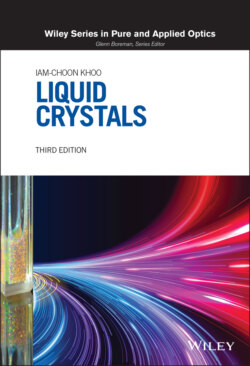Читать книгу Liquid Crystals - Iam-Choon Khoo - Страница 28
1.5.4. Photosensitive and Tunable Optical Waveguide, Photonic Crystals, and Metamaterial Nanostructures
ОглавлениеMost liquid crystal cells are planar in structure with the appropriate liquid crystalline material sandwiched between two flat windows. Owing to their fluid nature and compatibility with many technologically important materials, liquid crystals can be easily incorporated into nonplanar structures/enclosures to fashion tunable optical or optoelectronic devices such as waveguides (wedge or fiber), photonic crystals (bulk or fibers), micro‐ring resonator, and an assortment of so‐called metamaterials or plasmonic nanostructures [39], cf. Figure 1.24.
Liquid crystal‐guided wave optics such as planar and fiber waveguides are among the earliest to be investigated [40–42]. In these optical structures, liquid crystals are introduced either as the wave‐guiding cores or the adjacent claddings to the wave‐guiding structures; by modulating the liquid crystalline properties with an external field, the transmission and reflection properties of such waveguides can be correspondingly modulated. Other studies have employed more complex structures such as photonic crystals [43] or so‐called holey fibers [44], where additional mechanisms at work such as bandgaps and special band‐edge dispersions create a rich variety of transmission/reflection modulation possibilities. With the advent of nanotechnologies as well as the optical physics and electromagnetic theories of sub‐wavelength structure, liquid crystal cladded micro‐ring resonator [45], plasmonic waveguides [46], and metamaterials [47–49] with unusual tunable optical (UV – THz) and electromagnetic (GHz, microwave) properties have been actively investigated in recent years.
Figure 1.24. Tunable micro‐ and nano‐photonic structures incorporating liquid crystals: (a) metamaterial; (b) plasmonics nano‐gold‐disk array; (c) tunable micro‐ring resonator; (d) photonic crystal inverse opal.
Nevertheless, although these structures exhibit tunable properties not possible with their passive counterparts, they are often beset with large optical losses and slow responses that hinder practical applications. The large optical losses in these structures are due mainly to random scatterings associated with the nonuniformity in director axis alignment and natural fluctuations, as well as absorption by the plasmonic (metallic) constituents. The slow responses are characteristic of the liquid crystalline axis reorientation by the applied field. Another common limitation of these LC impregnated nonplanar nanostructures, or nanostructures/particulates introduced into bulk LC, is the strong anchoring of LC molecules on boundary surfaces. This gives rise to an immobile nonresponsive LC layer, as schematically depicted in Figure 1.25.
The problem is especially acute in plasmonic nanostructures where the light‐induced electric field penetrates only a very small fraction of the surrounding LC, unlike their counterpart in conventional LC cells. In general, therefore, the observed effective tuning or switching ability of such plasmonic or metamaterial (including metasurfaces) nanostructures is generally much lower than theoretical predictions based on the entire LC region being reoriented.
Figure 1.25. Immobile LC layer around a plasmonic nanostructure (not drawn to scale) that exhibits tunable magnetic permeability in the optical wavelength region [47].
